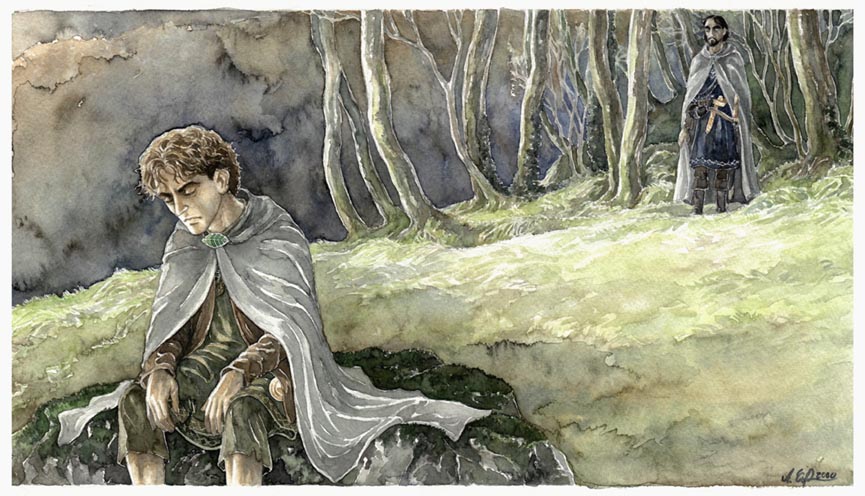The Two Towers by J.R.R Tolkien (Harper Collins 1991, 2007) pp. 775-784
We live in a world now in which there are so many communication devices that the palantír into which Pippin looked and in which he saw the Dark Lord himself might not seem so remarkable. And yet it is not so long ago when much of the world was not connected as it is now and the speed at which the world has changed has been so rapid that we have hardly had the time to think about all that has happened to us.

Peter Xavier Price shows us Pippin using his communication device under the skies of Rohan.
As a young man I taught in a school in Zambia, Central Africa, for six years in which there was only one phone and that was located in the headmaster’s house. I used that phone on only one occasion throughout the entire time that I was there. I now look back on that time as being a time of peace in which in order to communicate with someone I either had to go to see them or to write a letter.
But I also remember a conversation with a young Somali woman some years later who was in the UK for development studies. She spoke of her dream for her people and as I listened I became aware that this was an occasion for treading softly. She spoke of how she imagined every group of wandering herdsmen among her people possessing a communication device and how, as they sat around their campfires at night they could speak to each other, telling of where there was good pasture for their animals or of dangers to avoid. As she spoke my heart was carried out to the beauty of the African night and the soft beauty of African languages that I had heard there. Words spoken quietly in the still of the night under glittering starlight and the air feels like silk upon your face.

A herdsman looking into his device in the hills of Lesotho, Southern Africa.
We can see why Elendil would have wanted the capacity to communicate in this way across his kingdoms in Middle-earth although how these seeing stones, created by Fëanor himself in the depths of time, came to be in his possession and not in the hands of the kings of Númenor I cannot tell. There were three stones in Gondor and three in Arnor and one in Orthanc, a fortress that in the early years of the two kingdoms linked them both. In an age in which a message sent from Osgiliath in Gondor to Annúminas in Arnor would have taken weeks even upon upon the swiftest horses such devices would have been of great value.
But in the years of the decline of Arnor all its stones were lost. One remained in Minas Tirith in Gondor although at this point in the story as Gandalf rides there with Pippin upon Shadowfax we do not know about its existence. Gandalf tells Pippin that the stone that Sauron possesses came from Minas Ithil, the tower of the moon, that is now the city of the Lord of the Nazgûl, Minas Morgul, and an evil place. And there was still the stone of Orthanc that is now in the possession of Aragon, Elendil’s heir, and to whom it rightfully belongs.
There is a mystery about the stones that Fëanor made so long ago that is conveyed in the stars that shone when Pippin first looked into it and the swirling images that cleared when at the last the Dark Lord came himself. And we are left with two questions. Is a palantír simply a communication device such as the ones that we all carry as a matter of course, or are our devices more mysterious than we usually think? Perhaps the answer is yes to both questions. Yes, perhaps the Stone of Orthanc is nothing more than the devices that we carry about with us all the time, and yes, our devices have something more of a palantír about them than we usually recognise.
It is easy for us to see in the palantíri of The Lord of the Rings a spiritual power at work, a battle between the wills of those who look into them, a battle in which it is wise not to regard one’s own power too highly, as Saruman did. Gandalf is relieved that he was saved from a battle of wills with Sauron by Pippin’s foolish act. But we have become so used to the devices that we carry that we are not aware of their spiritual nature and so, like Saruman, we look into them, confident in our own ability to deal with all that we see there, unaware that other wills are at work as well as our own. Unaware, perhaps, until we are trapped by them and we are enslaved to the will of others, whose power is so much greater than ours.

Saruman believes that his will is strong enough for him to use a communication device safely at all times.























